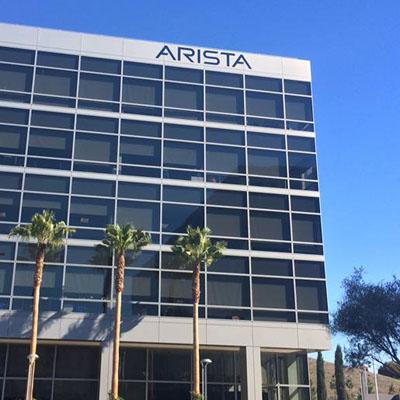Arista Networks Exec On New Container Software Offensive And Its 'Biggest Fundamental Advantage' Over Cisco

Arista's New cEOS
Arista Networks has unveiled a new containerized version of its flagship EOS operating system that can run on white-box hardware while also enabling customers like Facebook and Google "to make a switch look just like a server," said Jeff Raymond, vice president of EOS products and services.
"This idea of containerization is not a new concept, but it really hasn't been exercised in the networking stack or networking world. When we're able to apply it to networking, we get a lot of benefits that have to do with how we package our software," said Raymond in an interview with CRN.
Raymond spoke with CRN about the differentiation Arista's new containerized operating system (cEOS) brings to the market, channel partner opportunities and the Santa Clara, Calif.-based vendor's biggest software advantage over networking rival Cisco.

Why should Arista customers be excited about your new cEOS?
The primary benefit that this containerized packaging and containerized EOS provides is the ability to seamlessly integrate into our customers' own workflow. The secondary benefit is it helps our customers choose other flexible platform options. Whether it's their own Linux distribution or their own hardware platform, that's where [the] point about white-box, third-party hardware comes in.
The customer use case for this wasn't just to support third-party hardware, it was to integrate more specifically into their workflows and into their DevOps framework. That's what we've really tried to do here.

What specific market are you targeting with cEOS? Is it your Facebook and Google large web-scale customers?
We are positioning this, at least for today, as a solution for a small subset of customers -- really the largest and most sophisticated cloud operators are who we built this for today. We expect it to be more broadly applicable over time. So we've introduced this technology direction of containerized EOS and right now we're in the early adopter phase of that.

How important is it for Arista to get deeper into these Facebook and Google environments and winning over the Web 2.0 market?
It's very important because we're furthering our new technology direction. … It is an important milestone in Arista's growth here. A lot of our largest customers are already these large Web 2.0, cloud titan customers. That's where we focus. We have over 4,200 customers worldwide. So it's not just those large ones, but those drive a lot of our road map, that's where we have the tightest engagements, and that drives some of our biggest volume.

Will Arista channel partners be able to sell cEOS? What advice would you give Arista partners on to how to sell or leverage cEOS?
This is not for everyone. We're doing this technology launch to establish this direction and the early adopters will be the large, more sophisticated customers that are doing things themselves in a software approach.
But there is a very common use case across any customer, which is using a containerized EOS deployment for simulation and validation. You can actually build out virtual infrastructure using containerized EOS very quickly and simulate an environment with a relatively lightweight approach, and that could be helpful for a channel partner to be able to validate a new design, roll out a new feature, test some proof of concepts or just do training on the EOS platform.

How does your overall EOS software approach differentiate you from Cisco?
We have a single EOS binary image across all of our platforms, which has grown across four different merchant silicon architectures and 12 or 13 discrete chips sets. With that, we're able to maintain some operational balance and cost for our customers because you don't have to certify different versions on every single hardware platform that you might choose. That same principle is applied to cEOS. … It's still all the same software train that runs across our largest chassis down to our smaller switches. That's the biggest fundamental advantage on the software side relative to Cisco or really any of our competition, it's that we still maintain those core software principles.

What's one key software advantage Arista has over your competition?
We are the only vendor who has been built on an unmodified Linux kernel and that makes this containerized EOS much more beneficial because customers themselves can say, 'If I have my own Linux distribution, I can now run it on my switches as well and get the full feature set of EOS packaged in a container on top of that Linux kernel.'

Why is the unmodified Linux kernel so important? How does it give you a leg up in the market?
Because when you look across the industry, just about every vendor will say they're based on Linux. But the difference is that they've taken an initial Linux base and they've heavily modified that kernel. So their dependencies on that very specific kernel is very tight and it doesn't give them the flexibility to be disaggregated from the Linux kernel or disaggregated from the hardware platform in quite the same way. … It does give us flexibility to follow and adopt software trends and apply them to networking.

When will cEOS be made generally available?
Right now, we're in trials with cEOS at a small handful of customers. This is on a limited engagement that we have right now. We plan to make containerized EOS more general in the second half of the calendar year.
Why is cEOS so important for these giant web-scale 2.0 companies?
Because their infrastructure is massive. It's such a significant difference on how those networks are built versus other networks, it's exponentially different in scale. To operate that, the approach is automation.
When you have literally hundreds of thousands of severs, you can't just operate them manually box by box or even with large teams – you need to automate through software. … They're using software to run their infrastructure [so] uniformity becomes a key to how they automate.

Can you elaborate more on uniformity and why cEOS is key here?
So these cloud operators build these large orchestration systems and assume that there's a uniformity across all the devices and entities in that infrastructure. That's why these large guys will basically design a hardware specification for their servers and also have a corresponding software specification for their software stack so every single sever out there looks exactly the same … They assume that there's an underlying OS.
They said 'If we have 100,000 servers in our environment and several thousands of switches, if we can have the top-of-rack switch look like a server to our orchestration system, we can integrate that into our automation and orchestration framework.' Therefore, [customers] gain further efficiencies of the software that they're already writing for their infrastructure. So the goal was to produce cEOS, which is the same EOS as we have everywhere else, but package it in a way that fits into that framework. In other words, it lets that switch look just like a server that is uniformly built throughout that infrastructure.

How do you package EOS to make a switch look like a server?
The way we do that is we package EOS in a container. It runs on a Docker runtime environment [and] other containerized apps. … The customers get their flexibility to run their own Linux distribution. With EOS, we package our own Linux distribution. So if a customer downloaded EOS from our website, they would get a combination of the user applications as well as packaged with an unmodified Fedora Linux kernel.
Since that Lunix kernel has been unmodified all these years, the ability to effectively switch to a different Linux kernel … is possible. It makes that switch look just like the rest of the servers in their environment. And again, back to the point of integration into their broader infrastructure automation framework. That's the real use case that was driving us to do cEOS.

What should customers and partners take away from Arista's new cEOS?
This is really about applying more general software principles to networking. This idea of containerization is not a new concept, but it really hasn't been exercised in the networking stack or networking world. When we're able to apply it to networking, we get a lot of benefits that have to do with how we package our software.
This is another extension of our software approach and giving our customers – who are taking their own software approach to infrastructure – another tool in their tool set to make EOS that much easier to integrate into their software infrastructure models.